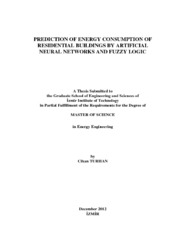Please use this identifier to cite or link to this item:
https://hdl.handle.net/11147/3535Full metadata record
| DC Field | Value | Language |
|---|---|---|
| dc.contributor.advisor | Gökçen Akkurt, Gülden | en |
| dc.contributor.author | Turhan, Cihan | - |
| dc.date.accessioned | 2014-07-22T13:51:45Z | - |
| dc.date.available | 2014-07-22T13:51:45Z | - |
| dc.date.issued | 2012 | en |
| dc.identifier.uri | http://hdl.handle.net/11147/3535 | - |
| dc.description | Thesis (Master)--Izmir Institute of Technology, Energy Engineering, Izmir, 2012 | en |
| dc.description | Includes bibliographical references (leaves: 61-65) | en |
| dc.description | Text in English; Abstract: Turkish and English | en |
| dc.description | xii, 81 leaves | en |
| dc.description | Full text release delayed at author's request until 2016.01.30 | en |
| dc.description.abstract | There are several ways to attempt to forecast building energy consumption. Different techniques, varying from simple regression to dynamic models that are based on physical principles, can be used for simulation. A frequent hypothesis for all these models is that the input variables should be based on realistic data when they are available, otherwise the evaluation of energy consumption might be under or over estimated. The aim of this thesis is to create simple models based on artificial intelligence methods (artificial neural networks and fuzzy logic) as predicting tools and to compare these methods with a building energy performance software (KEP-IYTE ESS). Architectural projects and heat load calculation reports of 148 apartment buildings (5-13 storey) from three municipalities in Ġzmir provide the input data for the models and software. Building energy consumption is modeled as a function of zoning status, heating system type, number of floors, wall overall heat transfer coefficient, glass type, area/volume ratio, existence of insulation, total external surface area, orientation, number of flats, total external surface area/total useful area, total windows area/total external surface area, width/length, total wall area/total useful floor area, total lighting requirement/total useful floor area and total wall area. Four different artificial neural network models and one fuzzy logic model were constructed, trained, tested and the results were compared with the software outcomes. The lowest mean absolute percentage error (MAPE) and mean absolute deviation (MAD) of ANN models appeared to be 4.1% and 6.57, respectively, which shows that ANN can make accurate predictions. On the other hand, fuzzy model gave an 4.86% and 7.59 of MAPE and MAD, respectively, which can be considered as sufficient accuracy. | en |
| dc.language.iso | en | en_US |
| dc.publisher | Izmir Institute of Technology | en |
| dc.rights | info:eu-repo/semantics/openAccess | en_US |
| dc.subject.lcsh | Buildings--Energy conservation | en |
| dc.subject.lcsh | Dwellings--Energy consumption | en |
| dc.subject.lcsh | Dwellings--Energy conservation | en |
| dc.subject.lcsh | Neural networks (Computer science) | en |
| dc.subject.lcsh | Fuzzy logic | en |
| dc.title | Prediction of energy consumption of residential buildings by artificial neural networks and fuzzy logic | en_US |
| dc.type | Master Thesis | en_US |
| dc.institutionauthor | Turhan, Cihan | - |
| dc.department | Thesis (Master)--İzmir Institute of Technology, Energy Systems Engineering | en_US |
| dc.relation.publicationcategory | Tez | en_US |
| item.languageiso639-1 | en | - |
| item.fulltext | With Fulltext | - |
| item.openairecristype | http://purl.org/coar/resource_type/c_18cf | - |
| item.openairetype | Master Thesis | - |
| item.grantfulltext | open | - |
| item.cerifentitytype | Publications | - |
| Appears in Collections: | Master Degree / Yüksek Lisans Tezleri | |
Files in This Item:
| File | Description | Size | Format | |
|---|---|---|---|---|
| 458514.pdf | MasterThesis | 1.96 MB | Adobe PDF |  View/Open |
CORE Recommender
Page view(s)
174
checked on Jul 22, 2024
Download(s)
90
checked on Jul 22, 2024
Google ScholarTM
Check
Items in GCRIS Repository are protected by copyright, with all rights reserved, unless otherwise indicated.